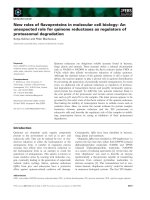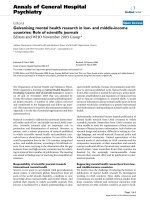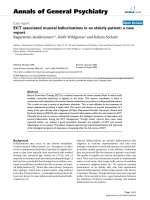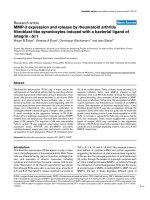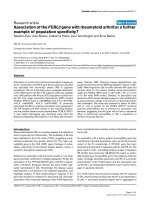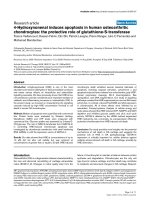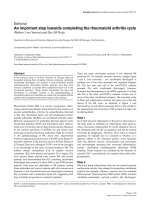Báo cáo y học: "Atherosclerotic disease is increased in recent-onset rheumatoid arthritis: a critical role for inflammation" ppsx
Bạn đang xem bản rút gọn của tài liệu. Xem và tải ngay bản đầy đủ của tài liệu tại đây (711.74 KB, 9 trang )
Open Access
Available online />Page 1 of 9
(page number not for citation purposes)
Vol 9 No 6
Research article
Atherosclerotic disease is increased in recent-onset rheumatoid
arthritis: a critical role for inflammation
Suad Hannawi
1
, Brian Haluska
2
, Thomas H Marwick
2
* and Ranjeny Thomas
3
*
1
Centre for Immunology and Cancer Research, University of Queensland, Princess Alexandra Hospital, Brisbane, QLD 4102, Australia
2
Department of Medicine, University of Queensland, Princess Alexandra Hospital, Brisbane, QLD 4102, Australia
3
Diamantina Institute for Cancer, Immunology and Metabolic Medicine, University of Queensland, Princess Alexandra Hospital, Brisbane, QLD 4102,
Australia
* Contributed equally
Corresponding author: Ranjeny Thomas,
Received: 10 May 2007 Revisions requested: 2 Jul 2007 Revisions received: 16 Oct 2007 Accepted: 6 Nov 2007 Published: 6 Nov 2007
Arthritis Research & Therapy 2007, 9:R116 (doi:10.1186/ar2323)
This article is online at: />© 2007 Hannawi et al., licensee BioMed Central Ltd.
This is an Open Access article distributed under the terms of the Creative Commons Attribution License ( />2.0), which permits unrestricted use, distribution, and reproduction in any medium, provided the original work is properly cited.
Abstract
Rheumatoid arthritis (RA) patients have increased mortality and
morbidity as a result of cardiovascular and cerebrovascular
disease. What is not clear, however, is either how early
accelerated atherosclerosis begins in RA or how soon risk
factors must be rigorously controlled. Furthermore, given the
strong relationship of vascular disease to RA mortality and of
inflammation to the accelerated atherosclerosis associated with
RA, it is important to evaluate indices that could serially and
noninvasively quantify atherosclerotic disease in RA patients.
The carotid intima-media thickness (cIMT) and plaque,
measured by ultrasound, correlate closely with direct
measurement of the local and systemic atherosclerotic burden.
To investigate the presence of subclinical atherosclerosis in the
early stages of RA, the cIMT and plaque were measured using
carotid duplex scanning in 40 RA patients with disease duration
< 12 months and in 40 control subjects matched for age, sex
and established cardiovascular risk factors. Patients with RA
had significantly higher average cIMT values and more plaque
than the control group (cIMT 0.64 ± 0.13 mm versus 0.58 ±
0.09 mm, respectively; P = 0.03). In RA patients, the cIMT was
predicted by age and C-reactive protein level at first
presentation to the clinic (R
2
= 0.64). C-reactive protein was
associated with age of disease onset and history of smoking.
Since inflammation has been shown to predate onset of clinical
RA, the accelerated atherogenic process related to
inflammation may precede RA symptom onset.
Introduction
Rheumatoid arthritis (RA) patients have significantly increased
mortality and morbidity as a result of cardiovascular (CV) dis-
ease and cerebrovascular disease [1]. Laboratory, clinical and
epidemiological studies suggest that immune dysregulation
and systemic inflammation play important roles in the acceler-
ated atherosclerosis of RA [2,3]. Although CV events are
major consequences of CV disease, these complications
develop over years, and the time course of epidemiologic and
clinical studies has been reduced using B-mode ultrasound
measurement of the carotid intima-media thickness (cIMT) and
of carotid plaque to study early atherosclerotic changes non-
invasively [4,5]. cIMT values measured by ultrasound correlate
closely with direct measurement of the local and systemic
atherosclerotic burden in pathology studies and with clinical
CV endpoints [4,6]. Ultrasonographic assessment of common
carotid atherosclerosis is a feasible, reliable, valid and cost-
effective method for both population studies and clinical trials
of atherosclerosis progression and regression [7].
While several studies have demonstrated subclinical athero-
sclerosis in established RA patients, either by increased cIMT
or the presence of carotid atherosclerotic plaque [8-14], no
study has examined the cIMT or plaque in early RA. This is an
important issue for several reasons. How early accelerated
atherosclerosis begins in RA, or how soon risk factors must be
rigorously controlled, is not clear. Furthermore, given the
strong relationship of CV disease to RA mortality, it is impor-
cIMT = carotid intima-media thickness; CRP = C-reactive protein; CV = cardiovascular; ECG = electrocardiogram; IMT = intima-media thickness;
RA = rheumatoid arthritis.
Arthritis Research & Therapy Vol 9 No 6 Hannawi et al.
Page 2 of 9
(page number not for citation purposes)
tant to evaluate indices that could serially and noninvasively
quantify atherosclerotic disease in RA patients. Given the
clear association of inflammation with accelerated atherogen-
esis and CV clinical outcomes in RA, we hypothesized that the
cIMT would be increased in RA patients even at an early stage
of RA, related to inflammatory factors associated with RA. To
investigate the presence of subclinical atherosclerosis in the
early stages of RA, we measured the cIMT in RA patients with
symptom duration <12 months and in a group of control indi-
viduals matched for age, sex and CV risk factors. A group of
conventional CV risk factors and indices of RA inflammatory
disease were analysed to determine their relationship to sub-
clinical atherosclerosis in RA patients.
Materials and methods
Rheumatoid arthritis patients
Patients (n = 40), including 13 men and 27 women with a
mean age of 53 years (range 22–78 years), were recruited at
first presentation between May 2004 and December 2005
when attending scheduled appointments at our specialized
early RA clinic. All patients aged 18 years or older attending
the early RA clinic during the study recruitment period were
invited to take part in the study. All participants met the Amer-
ican College of Rheumatology 1987 revised criteria for diag-
nosis of RA. At presentation, five patients were taking low-
dose prednisone, and three patients were using nonsteroidal
anti-inflammatory drugs or cyclooxygenase-2 inhibitors.
Unless contraindicated, all RA patients were started on triple
therapy of methotrexate, sulphasalazine and hydroxychloro-
quine after RA diagnosis was confirmed, and the doses were
titrated over time according to disease activity criteria with the
aim of achieving clinical remission.
Nonrheumatoid arthritis patients
Control subjects (n = 40) were healthy volunteers recruited
from the same geographical area, including 13 men and 27
women with a mean age of 53 years (range 21–80 years),
matched to the RA patients' age, sex and CV risk factors. We
matched against a database of >1,000 cIMTs recruited in a
primary prevention setting. The primary match was for age and
gender, after which we matched for number and type of risk
factors on a categorical basis. While exact blood pressure or
lipid levels were not matched, we were able to match for
hypertension and hyperlipidemia, in addition to smoking status
in almost all the cases.
Study procedure
The study was approved by the human research ethics com-
mittee at Princess Alexandra Hospital, and all subjects pro-
vided written informed consent. RA patients underwent a
comprehensive clinical evaluation and measurements by a
rheumatologist and a clinical metrologist, including the Ameri-
can College of Rheumatology core set of disease activity cri-
teria, the Health Assessment Questionnaire and calculation of
the disease activity score. Demographic variables were ascer-
tained by questionnaire. Disease duration was determined by
the length of RA symptoms. Disease activity in RA patients
was measured using the disease activity score (DAS 4v), a val-
idated composite score incorporating tender joint counts (out
of 53) and swollen joint counts (out of 44), the erythrocyte
sedimentation rate, and the patient global assessment of dis-
ease activity (100 mm visual analogue scale) [15].
Cardiovascular risk factor ascertainment
CV risk factors were ascertained among RA patients and con-
trols at presentation. Cigarette smoking was assessed by
questionnaire, which included details about past and present
smoking habits, the number of cigarettes smoked per day and
the smoking duration. Diabetes mellitus was classified as
present if diagnosed by a physician or if patients were taking
antidiabetic medications.
History of previous angina was classified as present if it had
been reported by physician; and history of previous myocardial
infarction was classified as present if development of either,
first, a typical rise and gradual fall (troponin) or a more rapid
rise and fall of biochemical markers of myocardial necrosis
(with at least one of ischaemic symptoms, development of
pathologic Q waves on ECG (electrocardiogram), or ECG
changes indicative of ischaemia (ST-segment elevation or
depression)) or, second, either new pathological Q waves on
serial ECGs or pathological changes of healed or healing myo-
cardial infarction was reported [16].
History of stroke or transient ischaemic attack was defined by
admission to the hospital with computed tomography evi-
dence of ischaemic occlusion or with carotid endarterectomy,
or presentation with stroke/transient ischaemic attack symp-
toms with significant plaque on carotid ultrasound and neuro-
logical sequelae, with exclusion of subarachnoid haemorrhage
and space-occupying lesions. Family history of CV attack or
cerebrovascular attack before age 65 in first-degree relatives
was determined by questionnaire.
The body mass index was calculated as weight (kilograms)
divided by the square of the height (metres). History of hyper-
cholesterolemia and hypertension were determined by diagno-
sis and recording as such in medical records by a physician,
or use of lipid-lowering drugs or antihypertensive medication.
Blood pressure was measured at first presentation.
The 10-year coronary risk was calculated using the Framing-
ham equation. Laboratory data included fasting total choles-
terol levels, low-density lipoprotein levels, high-density
lipoprotein levels, very-low-density lipoprotein levels, triglycer-
ide levels, glucose levels, C-reactive protein (CRP) levels, the
erythrocyte sedimentation rate, haemoglobin levels, anticitrull-
inated peptide levels, rheumatoid factor levels, antinuclear
antibodies, and high-resolution HLA-DRB genotyping.
Available online />Page 3 of 9
(page number not for citation purposes)
Measurement of intima-media thickness and plaque
Analyses were carried out on RA patients within 1–4 weeks
after RA diagnosis, and generally before commencement of
antirheumatic therapy. Ultrasound images were frozen by ECG
triggering (top of R-wave) to minimize variability depending on
changes in the cIMT and lumen diameter occurring during the
cardiac cycle [7,17]. Offline analysis of the images was per-
formed on a workstation using standard software for auto-
mated measurement of the intima-media thickness (IMT)
(QLab 4.2.1 with IMT plugin, version 1.1; Philips Ultrasound,
Bothell, WA, USA). The algorithm uses a maximum-slope
edge-detection technique, beginning in the vessel lumen and
detecting the first maximum slope of the change in signal for
the near and far walls, and repeating the analysis to identify the
media–adventitia interface. The software calculates the mean
and standard deviation for the IMT thickness in a region-of-
interest box, placed by the observer perpendicular to the ves-
sel walls, with the measurements performed on the R wave of
the ECG.
Care was taken not to include any plaque detected in the
carotid artery in the IMT measurement. Images were obtained
of the anterior, lateral and posterior views from both the right
and left carotid arteries; because of extraneous noise and gain
dependency in the near field, however, only the measurements
of far wall views were recorded. These measurements were
averaged to provide a mean IMT. The intra-observer variation
and the coefficient of variance of the IMT from this institution
are 0.01 ± 0.04 mm (5%). For each subject the average IMT
of six frozen images was calculated, and the mean cIMT ((left
+ right)/2) was taken as a measure of the wall thickness of the
distal common carotid artery.
Both extracranial carotid arterial systems were extensively
scanned to identify plaque, which was defined as a focal wid-
ening relative to adjacent segments, with protrusion into the
lumen composed of calcified deposits (hard plaque), noncal-
cified deposits (soft plaque) or a combination of calcification
and noncalcified material. Plaque was considered present if
visualized in the full diameter of the vessel; that is, both the
proximal and distal parts of the plaque were attached to the
typical double-lined intima-media structure and the double
lines were also visible on the opposite side of the lumen [18].
Examination and analysis of the cIMT and plaque were per-
formed by the same investigator (SH).
Statistical analysis
Continuous variables are described as the mean ± standard
deviation, and categorical variables presented as the percent-
age. Log transformations were applied to non-normally distrib-
uted data. The chi-squared test was used to analyse
categorical variables. cIMT differences between RA patients
and controls were tested with a two-sample t test. The associ-
ation of the cIMT with age, continuous CV variables and dis-
ease activity variables was evaluated using linear regression
analysis.
In the absence of previous cIMT data in early RA, an a priori
power calculation was not possible concerning the study sam-
ple size. Based on an expected IMT of 0.58 ± 0.09 (the mean
in middle-aged asymptomatic primary prevention patients in
our practice), however, we anticipated that a group of 40 early
RA patients and 40 matched control individuals would have a
90% power to permit the detection of the expectation of a
10% greater IMT in RA patients, and a significant difference (P
< 0.05) in the IMT between RA patients and control subjects.
In view of the sample size of 40, the four variables that were
significant at P ≤ 0.01 on univariate linear regression analysis
were analysed in a multivariate backwards stepwise linear
regression model.
Logistic regression was used to look for correlations between
CRP levels <5 and ≥ 5 with traditional CV risk factors. A CRP
value of 5 was chosen as a clinically useful discriminator of val-
ues above and below the normal reference range.
Mediation analysis was carried out as previously described,
where indicated [19]. All analyses used Stata 9/SE statistical
software (Stata Corp, College Station, Texas, USA).
Results
Clinical features
Forty patients presenting with definite RA within 12 months of
symptom onset were studied (Table 1). Three of these patients
had previous CV events, including one male with a previous
transient ischaemic attack at 52 years of age and two males
with angina at age 48 and 64 years, with a myocardial infarc-
tion at age 48 in one of those patients. Except for one patient
with rheumatoid nodules, no patient had developed extraartic-
ular manifestations at presentation. The most prevalent CV risk
factor was history of smoking; patients and controls were
matched for age, sex and all traditional CV risk factors, with no
statistically significant difference between the two groups
(Table 2).
Carotid intima-media thickness
When compared with healthy matched control subjects, RA
patients exhibited a greater average cIMT than control sub-
jects (0.64 ± 0.13 mm versus 0.58 ± 0.09 mm, P = 0.03)
(Figure 1) and an increased prevalence of carotid atheroscle-
rotic plaque (14 (35%) versus 3 patients (7.5%), P = 0.01).
We repeated the analysis after removing patients with previ-
ous CV events and their controls, and the results did not differ
(0.63 ± 0.02 mm versus 0.57 ± 0.01 mm, P = 0.03). These
data indicate that patients presenting with early RA have
increased atherosclerotic burden as evidenced by increased
cIMT and carotid arterial plaque, compared with matched con-
trol subjects.
Arthritis Research & Therapy Vol 9 No 6 Hannawi et al.
Page 4 of 9
(page number not for citation purposes)
Determinants of carotid intima-media thickness
Univariate and multivariate analyses were carried out to deter-
mine CV risk factors or inflammatory factors that might contrib-
ute to atherosclerosis in early RA. A positive association was
shown between the cIMT and the CRP level, the disease activ-
ity score (DAS 4v), age, male sex, the pack-year history of
smoking, history of smoking and systolic blood pressure at the
time of presentation with RA (Table 3 and Figure 2). The slope
of the regression line with age was steeper in RA patients
(slope = 0.011, R
2
= 0.58) than in control individuals (slope =
0.009, R
2
= 0.66), suggesting a more rapid rate of thickening
of cIMT in RA patients than controls with increasing age (Fig-
ure 2). RA patients with previous CV events and their matched
control subjects were removed for this analysis. After addition
of RA as an interactive term to the regression analysis, the
presence of RA did not affect the relationship between age
and cIMT. The role of inflammatory activity became clearer
upon multivariate analysis, which revealed a strong association
between the cIMT, age and CRP level at presentation (Table
3, adjusted R
2
= 0.64).
Determinants of C-reactive protein
We hypothesized that CRP and other markers of inflammation
were major contributors to the cIMT in RA, and this was indeed
the case. To further understand contributors to the cIMT in
early RA, we determined the relationship between the CRP
level at presentation and traditional CV risk factors. The CRP
level at disease onset was related to age (P = 0.016; Figure
2), and with each yearly increase in age there was a corre-
sponding 5% increase in probability of CRP > 5 (P = 0.035).
The low-density lipoprotein cholesterol level and triglycerides
showed a positive linear relationship to CRP, and the high-
density lipoprotein cholesterol level showed a negative linear
relationship to CRP level at disease onset (P < 0.05). Pres-
ence of CRP > 5 was significantly associated with a history of
smoking (P = 0.015). Those who had ever smoked were at
greater risk of CRP > 5, with an odds ratio of 5.6 (P = 0.019).
History of smoking was the only variable to maintain a signifi-
cant association with CRP level at presentation in a multivari-
ate model (P = 0.02). Further analysis demonstrates no
mediation of CRP on the relationship of cIMT with traditional
CV risk factors, except for body mass index.
Discussion
In the present study, we sought evidence of subclinical athero-
sclerosis by carotid ultrasound in patients presenting with
recent-onset RA. Using this technique, the cIMT or carotid
plaque are markers of atherosclerotic burden, and correlate
with CV outcome [4-6]. Patients with established RA have
been shown to exhibit significantly greater cIMT or plaque than
matched control subjects [8-14]. Our data are the first to show
an increased cIMT and increased plaque, and thus show
accelerated atherosclerosis in patients at first presentation
with symptoms of RA. While our study was too small to effec-
tively model factors associated with cIMT in early RA, age and
baseline CRP emerged from our analysis as the key determi-
nants of cIMT in early RA, which deserve further testing in
future studies.
Age and the cIMT were closely associated in both our patient
and matched healthy control populations. This reflects previ-
ous studies of cIMT in established RA patients and in the
general population [9,13,20]. Although the control group
showed a similar association between IMT and age, the RA
patients' cIMT was significantly higher than that of the con-
trols. This indicates that while age is a strong risk factor for
increased cIMT, it is not enough to explain the increased
incidence of subclinical atherosclerosis in RA patients. In addi-
tion, the baseline CRP level showed a significant relationship
with age, suggesting that patients who develop RA later in life
tend to have higher levels of inflammation at first presentation,
putting them at higher risk of CV and atherosclerotic disease.
In support, previous studies identified inflammatory activity to
be important for the development of CV disease in RA, even
after adjustment for traditional CV risk factors [21-24]. The
Figure 1
Carotid intima media thickness in rheumatoid arthritis patients com-pared with matched healthy control individualsCarotid intima media thickness in rheumatoid arthritis patients com-
pared with matched healthy control individuals. The carotid intima
media thickness (IMT) is increased in rheumatoid arthritis (RA) patients
compared with healthy control individuals matched for age, sex and car-
diovascular risk factors. Representative carotid ultrasound images from
three matched RA patient and control individual pairs: (a) a 42-year-old
male with RA and a 40-year-old control male, (b) a 58-year-old male
with RA and a 58-year-old control male, and (c) a 31-year-old female
with RA and a 31-year-old control female. The automated measurement
lines over the region of interest are boxed (in blue).
Available online />Page 5 of 9
(page number not for citation purposes)
consistent association of cIMT with inflammatory markers sup-
ports the evidence that CV mortality in RA patients is associ-
ated with inflammation. Previous studies have consistently
shown that excess CV mortality in RA is associated with base-
line or subsequent evidence of high levels of inflammation,
including elevated CRP, elevated erythrocyte sedimentation
rate and elevated swollen joint counts [5,25-27]. Several stud-
ies also demonstrate the association of older age at RA onset,
smoking, hypertension and male gender on CV mortality [5,25-
27]. We further show here that CRP is a major risk factor for
atherosclerosis in patients first presenting with RA. The cur-
rent data identify the same set of variables – age, smoking,
blood pressure and indices of disease activity – to be associ-
ated with increased cIMT in early RA as are associated with
CV mortality. Moreover, inflammatory and traditional CV risk
factors are correlated rather than acting independently on
cIMT.
The cIMT assesses the atherosclerotic burden and provides
information that is independent and incremental to that pro-
vided by standard risk factors. Noninvasive tools such as
ultrasound measurement of the cIMT may be useful to better
understand risk levels in primary prevention [28]. Age-specific
cIMT nomograms should be helpful in determining age-appro-
priate cIMT values [20], and may be used to identify subclinical
atherosclerosis in RA patients. This information could be used
Table 1
Demographic details, rheumatoid arthritis characteristics, and laboratory values of 40 rheumatoid arthritis patients at first
presentation
Demographic detail Value
Male:female 13:27
Mean age (years) 53 (22–78)
Male mean age (years) 58 (37–78)
Female mean age (years) 51 (22–72)
Body mass index (kg/m
2
) 28 (17–45)
Rheumatoid arthritis characteristics
Disease duration (months) 7 (1.0–12)
Tender joint count (out of 53) 19 (14)
Swollen joint count (out of 44) 16 (10)
Patient's assessment of fatigue (visual analogue scale, maximum 100) 38 (28)
Health assessment questionnaire score (maximum disability 24) 4.4 (4.5)
Physician's global assessment of disease activity (maximum 100) 41 (26)
Joint pain (visual analogue scale, maximum 100) 50 (31)
Morning stiffness duration (min) 195 (358)
Rheumatoid factor level 228 (302)
Disease activity score (DAS 4v) 4.39 (1.6)
Rheumatoid factor positive (n (%)) 30 (75%)
Laboratory values
Erythrocyte sedimentation rate (mm/hour) 36.5 (24)
C-reactive protein (mg/l, normal <6) 25.5 (23)
Haemoglobin (g/l) 131 (15)
Cholesterol (mmol/l) 5.0 (1.0)
Triglyceride (mmol/l) 1.4 (0.9)
High-density lipoprotein level (mmol/l) 1.5 (0.4)
Total high-density lipoprotein/cholesterol ratio (mmol/l) 3.6 (1.2)
Low-density lipoprotein cholesterol (mmol) 2.8 (0.7)
Antinuclear antibody titre >1:160 (n (%)) 28 (70%)
Data presented as mean (range) or mean (standard deviation), unless indicated otherwise.
Arthritis Research & Therapy Vol 9 No 6 Hannawi et al.
Page 6 of 9
(page number not for citation purposes)
Table 2
Established cardiovascular risk factors in 40 patients with early rheumatoid arthritis and in 40 control individuals
Variable Rheumatoid arthritis patients Control individuals P value
Cholesterol (mmol/l)
a
5.0 (1.0) 5.1 (1.0) 0.84
Triglyceride (mmol/l)
a
1.4 (0.9) 1.4 (0.9) 0.92
low-density lipoprotein cholesterol (mmol/l)
a
2.8 (0.7) 3.0 (0.9) 0.80
high-density lipoprotein cholesterol (mmol/l)
a
1.5 (0.4) 1.5 (0.4) 0.87
Body mass index (kg/m
2
)
a
28 (7.6) 28 (5.7) 0.96
Smoking, ever
b
26 (65) 24 (60) 0.64
History of hypertension
b
7 (18) 11 (28) 0.28
History of diabetes mellitus
b
5 (12) 5 (12) 1
History of hypercholesterolemia
b
3 (8) 6 (15) 0.29
History of myocardial infarction
b
1 (2) 0 -
History of angina
b
2 (5) 0 -
History of stroke and/or transient ischaemic attack
b
1 (2) 0 -
Family history of cardiovascular disease
b
6 (15) 10 (25) 0.26
Systolic blood pressure
b
122 (24) 124 (18) 0.55
Diastolic blood pressure
b
74 (10) 77 (9.6) 0.19
10-year coronary risk
b
10(8.7) 9.1(7.4) 0.56
Data presented as
a
mean (standard deviation) or
b
n (%).
Table 3
Linear regression analysis of carotid intima-media thickness, rheumatoid arthritis features and cardiovascular risk factors in recent-
onset rheumatoid arthritis patients
Variable R
2
value Standardized β coefficient Standard error t value P value Confidence interval
Univariate model
Number of swollen joints 0.12 0.391 0.041 2.25 0.032 0.008–0.174
Disease activity score (DAS4v)
a
0.16 0.431 0.079 2.74 0.01 0.056–0.377
C-reactive protein level (mg/l)
a
0.14 0.407 0.025 2.71 0.01 0.018–0.121
Rheumatoid factor presence
b
0.047 0.54 0.072–0.117
Age at onset of rheumatoid arthritis
a
0.56 0.759 0.001 7.19 <0.001 0.008–0.014
Male sex
b
0.066 0.018 -0.298 to -0.030
Pack-year history 0.10 0.320 0.001 2.09 0.044 0.000–0.005
History of smoking, ever
b
0.062 0.002 -0.329 to -0.079
Systolic blood pressure
a
0.27 0.540 0.184 3.63 <0.001 0.292–1.040
Cholesterol level 0.01 0.146 0.197 0.82 0.417 -0.564 to -0.239
Multivariate model
Age at onset of rheumatoid arthritis 0.64 0.002 6.11 <0.001 0.007–0.012
C-reactive protein level (mg/l) 0.001 2.18 0.038 0.000–0.004
Adjusted R
2
of the multivariate linear regression model = 0.69.
a
Variables entered into the multivariate model. Parameters determined by univariate
linear regression analysis or t test
b
.
Available online />Page 7 of 9
(page number not for citation purposes)
in decision-making regarding preventive measures including
statin therapy [29], although further studies are needed to
define whether this strategy is effective. In addition to monitor-
ing CV risk factors and inflammatory activity, this technique
might be useful to monitor progression of atherosclerosis over
time [21].
Smoking is clearly a risk factor for RA development, smoking
exacerbates RA severity, and smoking is a risk factor for the
IMT and CV outcome in RA and non-RA patients [5,25,30-35].
Moreover, smoking promotes the development of anticitrulli-
nated peptide autoantibodies in individuals with RA suscepti-
bility HLA-DRB1 alleles, occurring potentially years before the
development of clinical RA [36,37]. Our study demonstrates
significant associations between the cIMT, smoking and CRP
in early RA patients, supporting the concept that smoking is
associated with more severe inflammation at disease presen-
tation. Indeed, considering that 65% of participants had a his-
tory of smoking, it is difficult to separate the influence on the
cIMT of CRP levels alone from CRP levels promoted by the
oxidative environment of smoking. The data therefore strongly
suggest inflammation that precedes the onset of joint symp-
toms in RA promotes the development of atherosclerotic dis-
ease well before the first manifestations of joint disease, and
that the pathogenesis of atherosclerosis is linked to that of
autoimmune joint disease [38-40]. This conclusion is consist-
Figure 2
Coassociation of carotid intima media thickness, age and rheumatoid arthritis inflammatory activityCoassociation of carotid intima media thickness, age and rheumatoid arthritis inflammatory activity. The carotid intima media thickness (cIMT) was
measured in 37 rheumatoid arthritis (RA) patients with disease duration <12 months and in 37 control subjects matched for age, sex and cardiovas-
cular risk factors. The cIMT was plotted against (top left) age at RA diagnosis, (top right) age of controls, or (bottom left) the C-reactive protein
(CRP) level at first presentation with RA. (Bottom right) CRP at first presentation plotted against history of smoking. Data presented as mean ±
standard deviation. * p < 0.05
Arthritis Research & Therapy Vol 9 No 6 Hannawi et al.
Page 8 of 9
(page number not for citation purposes)
ent with previous studies demonstrating either early CV mor-
tality after onset of inflammatory polyarthritis or a lack of
association of disease duration with CV mortality, suggesting
that the increased risk of CV death was already present at RA
diagnosis [5,25]. Our data strongly emphasize the importance
of controlling CV risk factors, such as hypertension, smoking
and inflammatory activity early in the RA disease course, and
emphasize the critical influence of smoking on inflammation in
RA.
Conclusion
Early RA patients have increased atherosclerotic burden com-
pared with matched control individuals, predicted by age and
baseline CRP. Since inflammation has been shown to predate
the onset of clinical RA, the accelerated atherogenic process
related to inflammation may precede RA symptom onset.
Competing interests
The authors declare that they have no competing interests.
Authors' contributions
SH, BH, THM and RT were all involved in the conception,
design, acquisition, analysis and interpretation of the data. SH,
THM and RT drafted and revised the manuscript. All authors
read and approved the final manuscript.
Acknowledgements
The present work was supported by grants from the PA Hospital Foun-
dation and the Australian Rotary Health Research Fund, and by a schol-
arship from the Ministry of Higher Education, United Arab Emirates. RT
is supported by Arthritis Queensland. The authors thank Matthew Brown
for helpful discussions. There are no commercial affiliations.
References
1. Wolfe F, Mitchell DM, Sibley JT, Fries JF, Bloch DA, Williams CA,
Spitz PW, Haga M, Kleinheksel SM, Cathey MA: The mortality of
rheumatoid arthritis. Arthritis Rheum 1994, 37:481-494.
2. Carroll L, Hannawi S, Marwick T, Thomas R: Rheumatoid arthri-
tis: links with cardiovascular disease and the receptor for
advanced glycation end products. Wien Med Wochenschr
2006, 156:42-52.
3. Van Doornum S, Jennings GL, Wicks IP: Reducing the cardiovas-
cular disease burden in rheumatoid arthritis. Med J Aust 2006,
184:287-290.
4. Pignoli P, Tremoli E, Poli A, Oreste P, Paoletti R: Intimal plus
medial thickness of the arterial wall: a direct measurement
with ultrasound imaging. Circulation 1986, 74:1399-1406.
5. Goodson NJ, Symmons DP, Scott DG, Bunn D, Lunt M, Silman AJ:
Baseline levels of C-reactive protein and prediction of death
from cardiovascular disease in patients with inflammatory pol-
yarthritis: a ten-year followup study of a primary care-based
inception cohort. Arthritis Rheum 2005, 52:2293-2299.
6. Lorenz MW, Markus HS, Bots ML, Rosvall M, Sitzer M: Prediction
of clinical cardiovascular events with carotid intima-media
thickness: a systematic review and meta-analysis. Circulation
2007, 115:459-467.
7. Salonen JT, Salonen R: Ultrasound B-mode imaging in observa-
tional studies of atherosclerotic progression. Circulation 1993,
87:II56-II65.
8. Alkaabi JK, Ho M, Levison R, Pullar T, Belch JJ: Rheumatoid
arthritis and macrovascular disease. Rheumatology (Oxford)
2003, 42:292-297.
9. Kumeda Y, Inaba M, Goto H, Nagata M, Henmi Y, Furumitsu Y,
Ishimura E, Inui K, Yutani Y, Miki T, et al.: Increased thickness of
the arterial intima-media detected by ultrasonography in
patients with rheumatoid arthritis. Arthritis Rheum 2002,
46:1489-1497.
10. Park YB, Ahn CW, Choi HK, Lee SH, In BH, Lee HC, Nam CM, Lee
SK: Atherosclerosis in rheumatoid arthritis: morphologic evi-
dence obtained by carotid ultrasound. Arthritis Rheum
2002,
46:1714-1719.
11. Jonsson SW, Backman C, Johnson O, Karp K, Lundstrom E, Sun-
dqvist KG, Dahlqvist SR: Increased prevalence of atherosclero-
sis in patients with medium term rheumatoid arthritis. J
Rheumatol 2001, 28:2597-2602.
12. Cuomo G, Di Micco P, Niglio A, La Montagna G, Valentini G:
Atherosclerosis and rheumatoid arthritis: relationships
between intima-media thickness of the common carotid arter-
ies and disease activity and disability. Reumatismo 2004,
56:242-246.
13. Gonzalez-Juanatey C, Llorca J, Testa A, Revuelta J, Garcia-Porrua
C, Gonzalez-Gay MA: Increased prevalence of severe subclini-
cal atherosclerotic findings in long-term treated rheumatoid
arthritis patients without clinically evident atherosclerotic
disease. Medicine (Baltimore) 2003, 82:407-413.
14. Roman MJ, Moeller E, Davis A, Paget SA, Crow MK, Lockshin MD,
Sammaritano L, Devereux RB, Schwartz JE, Levine DM, et al.: Pre-
clinical carotid atherosclerosis in patients with rheumatoid
arthritis. Ann Intern Med 2006, 144:249-256.
15. van der Heijde DM, van't Hof MA, van Riel PL, van Leeuwen MA,
van Rijswijk MH, van de Putte LB: Validity of single variables and
composite indices for measuring disease activity in rheuma-
toid arthritis. Ann Rheum Dis 1992, 51:177-181.
16. Alpert JS, Thygesen K, Antman E, Bassand JP: Myocardial infarc-
tion redefined – a consensus document of The Joint European
Society of Cardiology/American College of Cardiology Com-
mittee for the redefinition of myocardial infarction. J Am Coll
Cardiol 2000, 36:959-969.
17. Bots ML, Hofman A, de Bruyn AM, de Jong PT, Grobbee DE: Iso-
lated systolic hypertension and vessel wall thickness of the
carotid artery. The Rotterdam Elderly Study. Arterioscler
Thromb 1993, 13:64-69.
18. Joakimsen O, Bonaa KH, Stensland-Bugge E: Reproducibility of
ultrasound assessment of carotid plaque occurrence, thick-
ness, and morphology. The Tromso Study. Stroke 1997,
28:2201-2207.
19. Baron RM, Kenny DA: The moderator–mediator variable dis-
tinction in social psychological research: conceptual, strategic,
and statistical considerations.
J Pers Soc Psychol 1986,
51:1173-1182.
20. Roman MJ, Naqvi TZ, Gardin JM, Gerhard-Herman M, Jaff M, Moh-
ler E: American society of echocardiography report. Clinical
application of noninvasive vascular ultrasound in cardiovascu-
lar risk stratification: a report from the American Society of
Echocardiography and the Society for Vascular Medicine and
Biology. Vasc Med 2006, 11:201-211.
21. Nagata-Sakurai M, Inaba M, Goto H, Kumeda Y, Furumitsu Y, Inui
K, Koyama H, Emoto M, Ishimura E, Shoji T, et al.: Inflammation
and bone resorption as independent factors of accelerated
arterial wall thickening in patients with rheumatoid arthritis.
Arthritis Rheum 2003, 48:3061-3067.
22. Del Rincon I, Williams K, Stern MP, Freeman GL, O'Leary DH,
Escalante A: Association between carotid atherosclerosis and
markers of inflammation in rheumatoid arthritis patients and
healthy subjects. Arthritis Rheum 2003, 48:1833-1840.
23. Wallberg-Jonsson S, Johansson H, Ohman ML, Rantapaa-Dahl-
qvist S: Extent of inflammation predicts cardiovascular disease
and overall mortality in seropositive rheumatoid arthritis. A ret-
rospective cohort study from disease onset. J Rheumatol
1999, 26:2562-2571.
24. Willerson JT, Ridker PM: Inflammation as a cardiovascular risk
factor. Circulation 2004, 109:II2-II10.
25. Maradit-Kremers H, Nicola PJ, Crowson CS, Ballman KV, Gabriel
SE: Cardiovascular death in rheumatoid arthritis: a population-
based study. Arthritis Rheum 2005, 52:722-732.
26. Book C, Saxne T, Jacobsson LT: Prediction of mortality in rheu-
matoid arthritis based on disease activity markers. J
Rheumatol 2005, 32:430-434.
27. Jacobsson LTH, Knowler WC, Pillemer S, Hanson RL, Pettitt DJ,
Nelson RG, Del Puente A, McCance DR, Charles M-A, Bennett
Available online />Page 9 of 9
(page number not for citation purposes)
PH: Rheumatoid arthritis and mortality: a longitudinal study in
Pima Indians. Arthritis Rheum 1993, 36:1045-1053.
28. Greenland P, Smith SC Jr, Grundy SM: Improving coronary heart
disease risk assessment in asymptomatic people: role of tra-
ditional risk factors and noninvasive cardiovascular tests. Cir-
culation 2001, 104:1863-1867.
29. Carroll L, Frazer IH, Turner M, Marwick TH, Thomas R: Receptor
for advanced glycation end products Glycine 82 Serine poly-
morphism and risk of cardiovascular events in rheumatoid
arthritis. Arthritis Res Ther 2007, 9:R39.
30. Wolfe F: The effect of smoking on clinical, laboratory, and radi-
ographic status in rheumatoid arthritis. J Rheumatol 2000,
27:630-637.
31. McEntegart A, Capell HA, Creran D, Rumley A, Woodward M,
Lowe GD: Cardiovascular risk factors, including thrombotic
variables, in a population with rheumatoid arthritis. Rheuma-
tology (Oxford) 2001, 40:640-644.
32. Padyukov L, Silva C, Stolt P, Alfredsson L, Klareskog L: A gene–
environment interaction between smoking and shared epitope
genes in HLA-DR provides a high risk of seropositive rheuma-
toid arthritis. Arthritis Rheum 2004, 50:3085-3092.
33. Silman AJ, Newman J, MacGregor AJ: Cigarette smoking
increases the risk of rheumatoid arthritis. Results from a
nationwide study of disease-discordant twins. Arthritis Rheum
1996, 39:732-735.
34. Diez-Roux AV, Nieto FJ, Comstock GW, Howard G, Szklo M: The
relationship of active and passive smoking to carotid athero-
sclerosis 12–14 years later. Prev Med 1995, 24:48-55.
35. Salonen R, Salonen JT: Determinants of carotid intima-media
thickness: a population-based ultrasonography study in east-
ern Finnish men. J Intern Med 1991, 229:225-231.
36. Klareskog L, Stolt P, Lundberg K, Kallberg H, Bengtsson C, Grune-
wald J, Ronnelid J, Harris HE, Ulfgren AK, Rantapaa-Dahlqvist S, et
al.: A new model for an etiology of rheumatoid arthritis: smok-
ing may trigger HLA-DR (shared epitope)-restricted immune
reactions to autoantigens modified by citrullination. Arthritis
Rheum
2006, 54:38-46.
37. Linn-Rasker SP, van der Helm-van Mil AH, van Gaalen FA, Klop-
penburg M, de Vries RR, le Cessie S, Breedveld FC, Toes RE,
Huizinga TW: Smoking is a risk factor for anti-CCP antibodies
only in rheumatoid arthritis patients who carry HLA-DRB1
shared epitope alleles. Ann Rheum Dis 2006, 65:366-371.
38. Vossenaar ER, Van Venrooij WJ: Citrullinated proteins: sparks
that may ignite the fire in rheumatoid arthritis. Arthritis Res
Ther 2004, 6:107-111.
39. Kraan MC, Versendaal H, Jonker M, Bresnihan B, Post WJ, t Hart
BA, Breedveld FC, Tak PP: Asymptomatic synovitis precedes
clinically manifest arthritis. Arthritis Rheum 1998,
41:1481-1488.
40. Rantapaa-Dahlqvist S, de Jong BA, Berglin E, Hallmans G, Wadell
G, Stenlund H, Sundin U, van Venrooij WJ: Antibodies against
cyclic citrullinated peptide and IgA rheumatoid factor predict
the development of rheumatoid arthritis. Arthritis Rheum 2003,
48:2741-2749.

